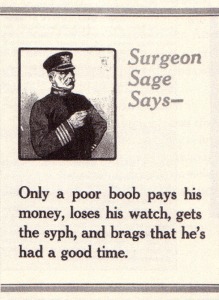A few months ago I found myself in need of knowing what access a feisty, experienced but unmarried girl would have to birth control in 1917. I took myself to the quick and dirty fountain of information, Wikipedia, where I learned that the most common methods of contraception at this time were condoms and cervical caps.
The US was the only army during the war that did not distribute condoms to their troops (figures; but this must have changed by the mid-twentieth century because I remember it being mentioned in ANGELA’S ASHES). But a girl with a trusted friend or lover in one of the other armies could potentially use the soldier as a source of contraception.

I was surprised to read about how common cervical caps were, but it’s not difficult to see they have many advantages over condoms, being reusable and in the woman’s control. They needed to be professionally fitted, so an unmarried girl wishing to use a cervical cap would need access to either a sympathetic physician or one not questioning fabricated martial status.
I read with interest Lesley A Hall’s post on contraception in the 1920s following an episode in Downton Abbey. Sadly I stopped being able to enjoy Downton Abbey after a hideously inappropriate incident of sexual violence, so I didn’t see this scene but it’s exactly the sort of thing that interests me. I was somewhat surprised by Hall’s assertion that it was unlikely the character would settle on condoms as her contraceptive of choice. I assumed that, given their availability and ease of use, condoms would have been a popular choice for preventing pregnancy. But perhaps their association with the prevention of venereal disease made them unpopular amongst otherwise respectable girls. How common was condom use amongst monogamous couples, married or otherwise?
The use of “sheaths” is very common in romance novels, but these usually depict an earlier era when the cervical cap was not yet invented, and also might be an example of a benign anachronism, where the promotion of safe sex takes precedence over strict historical accuracy.
I haven’t come across any overt discussions of contraceptive use in my research, but perhaps that is unsurprising. Descriptions of sexual activity, if present at all, tend to use such coded language that I wonder whether I just have an overactive imagination and I’m reading too much between the lines.
So what seems the most likely scenario? A cervical cap, fitted by a sympathetic doctor? Condoms acquired through either a trusted friend or by the man in question himself? Or an even older, less effective method of birth control? More research needed, I think. Perhaps at the British Library rather than Google.
To be continued…
Maybe you could ask the oldest person you know if they had an older relative who once told them about contraception – does that make sense? Basically try to get make to the original source of an average person! I think it’s a tricky one because it’s not the sort of thing people would have talked openly about. My grandma told me about being fitted for a cap (and how embarrassing it was etc as she was pretty shy) in the 1920s but she was married. I think condoms would be more likely for an unmarried girl, but that’s based on instinct rather than knowledge of the facts.
Zoe
LikeLike
Great story from your grandma! Sadly most of my older relatives have passed on, and I’m not sure how much experience they would have had being mostly from religious upbringings. I may ask around to friends of friends, though. I would guess most girls were not fitted for caps until they were married.
LikeLike